As mentioned previously, I recently bought a Crumar T2 organ manufactured in 1978 and started ascertaining its condition. Here’s what I’ve been able to fix so far and what I’ve been able to determine about the parts I haven’t yet fixed.
Crackly Volume Knobs and Stuck Master Tuning Potentiometer
Several of the volume knobs were pretty crackly.
Most Crumar keyboards are wonderful to service because of how easy it is to get inside. After removing a few screws, the top panel lifts back on its rear hinge, without even having to take the knobs off all the controls.
Crackly controls need wiper cleaner sprayed into them to loosen and remove the gunked-up graphite and grease built up on their resistive paths. As my can of wiper cleaner turned out to be empty, I used a spray can of silicone lubricant instead — it’s good at softening gunk and of course also at lubricating. Note that something in silicone lubricant (I’m guessing the solvent carrier) dissolves some kinds of plastic — this could be heartbreaking if used on something that mattered (like, say, the odometer from my ’67 Fairlane).
The panel-mounted controls (including the stuck master tuner) were easy to get to with the silicone spray, after which I worked them back and forth over their range to use the potentiometers’ wipers to work loose the now softened gunk. After a couple of applications, they now operate quietly.
Although I used a rag to protect the panel from overspray, I can see in the photo that silicone/solvent still oversprayed or later dripped out of the potentiometers and stained the interior of the cover.
Crackly Keys (Noticeable When Using Overdrive Effect)
Several keys on the upper manual cut in and out and crackle a bit, which is especially noticeable when running the keyboard through an overdrive processor.
In addition to top panels, Crumar manuals (keyboards) are typically hinged as well, lifting up to allow easy access to the underside of the keys and to circuitry underneath. (I love my Crumars!)
Hm, the undersides of the keys have downward-pointing tabs holding one end of springs that are probably being pushed down to make contact with a bus wire running the length of the keyboard. That looks like something I really don’t want to completely disassemble, clean and reassemble. Maybe I’ll fix some other things before worrying about the key crackle.
D♯ / E♭
Up and down the keyboard, the D♯ / E♭ key didn’t make any sound unless (A) I had the 1′ or 2′ drawbars pulled out and pressed one of the highest E♭s on the keyboard or (B) I had a non-octave drawbar pulled out. In other words, only the highest E♭ the organ could make was producing sound; lower octaves of E♭ were not.
Sidebar on Hammond organ drawbars and additive synthesis: Hammond organs and clones have drawbars labeled in feet (16′, 5 1/3′, 8′, 4′, 2 2/3′, 2′, 1 3/5′, 1 1/3′, 1′), with 8′ being the approximate length of pipe needed to make the pitch of the lowest note on the keyboard of a pipe organ and the other lengths representing lower and higher pitches. Each drawbar has nine positions (full off to full on) and mixes the amount of the corresponding pitch (fundamental, octave above, octave and a fifth above, etc.) into the sound created when you press a key, allowing you to create different timbres of sound (hollow, reedy, cathedral organ, etc.) for the same pitch.
Thus a failure of all the E♭s on the keyboard seemed like a problem with the tone generation, drawbar (selection), and/or mixing circuits. The manuals’ wiring harnesses break out to edge connectors:
Each edge connector appears to correspond to an octave’s worth of keys. The vertical backplane’s traces go down to a horizontal backplane and continue toward the front of the organ:
Where they disappear beneath a black cover, which I removed.
Yow, look at all those little circuit boards! Some have one IC on them and some have two; they’re divided into two banks (left and right) that match the wiring harnesses that coming from the upper and lower manuals; there are an awful lot of these little boards and there are an awful lot of keys on the manuals.
Hm, let’s have a look at what’s on them.
Looks like a TDA0470D with supporting resistors. So what’s a TDA0470D? Google gives:
- A Polish IC sales site listing it as a transistor array
- The Vintagechip site listing it as being used in Crumar T1s, among other things, and claiming that it’s a 10-transistor array and that at datasheet is available
- An edaboard.com post describing it in more detail as a multi-gate chip and claiming that it’s equivalent to the TBA470
- The MIDI Gadgets Boutique product selector page listing the TBA470 with datasheet
Transcribed:
Gate for Electronic Organs
Monolithic integrated circuit in bipolar technique, designed primarily for use in electronic organs. The device incorporates ten transistors, each replacing a mechanical key contact. Thus it is possible to reduce the numerous mechanical key-contacts on conventional organs (up to ten per key) to one single contact per key.
Each of the ten emitters may be driven by a tone-signal. The sum of all signals will be derived from the common collector (terminal 14) or if the signals are supplied into the base terminals, via an integrated diode from terminal 1. Any undesired peaks caused by blocked transistors are suppressed by this diode and an external capacitor.
So … the tones are presented on all of the inputs, a single key gates them, and this IC mixes them together? Sounds like these chips are the keys’ gate mechanisms for the drawbars, which is what the datasheet suggests. If each IC corresponds to one key and since the T2 had multiple keys with the same problem, I figured I needed to look further upstream toward the tone generation.
While looking at the gate PCBs, I noticed that just behind the long, front PCB, the backplane was labeled Do – Re – Mi – Fa – So – La – Si, with the positions of the notes approximately corresponding (with appropriate gaps for sharps) to the positions of the vertical traces on the front PCB. Perhaps the front PCB is involved in tone generation, then?
I pulled out one of the front PCB’s ICs (with the power off, then powered back up) and a whole swath of keys across the keyboard quit working. Ah ha! A little experimentation yielded that the leftmost IC makes all of the C – C♯ keys (not) work, the remaining upper ICs make all of the D – F♯ keys (not) work, and the lower ICs make all of the G – B keys (not) work. Now I was getting somewhere!
Further experimentation yielded that the upper of the highlighted ICs was the culprit; I could move it around to the other notes’ banks and the problem followed the IC.
So who is this mysterious stranger? A 4727BPC. Back to Google:
- At Datasheet Archive, a listing as a binary up counter claiming 15V supply
- A Synthforum post suggesting that it was CMOS
- And back to Vintage Chip, the HBF4727 and a claim that a datasheet was available.
Hoping to find more information about exactly what the chip did, I emailed Vintage Chip inquiring about a datasheet and was delighted to receive a reply within hours from Valter with a copy of the pinout attached. He doesn’t have a full datasheet but is expecting one within a month or two and will email me when he has it.
From the pinout, I could tell that the 4727BPC / HBF4727 is a bunch of independent toggle flip-flops used for octave division, which makes sense — the organ would have a circuit to generate all the pitches of its highest octave, then divide them into progressively lower octaves. The failure of one of the divider chips would cause lower octaves to stop producing tones, but the highest (original) octave would still be accessible from the highest drawbars of the highest keys.
Curiously, when I moved the faulty IC around within the range of ICs dividing D – F♯, I expected that I would get progressively more of the higher E♭s to work and only the lowest wouldn’t (because only the lowest weren’t being divided / generated), but my recollection is that all of the E♭s on the keyboard continued to not work. This seems odd.
In any case, because I want my dual-manual T2 working so I can practice on it, I borrowed a 4727BPC from my T1 and all the T2 keys now work fine.
Remaining Issues
Some of the keys are still crackly. I’m afraid I may have to disassemble all the keys and clean the springs and contacts.
When using the Line 6 POD guitar amp emulator to approximate John Lord’s overdriven Marshall stack, I hear a lot of static coming from the organ that I don’t hear with anything else plugged into the POD. I notice that all the op-amps in the T2 are 741s — maybe it’s time for an upgrade to TL081s (which as far as I can tell are pin-compatible, including the offset null).
I’ve left my T1 inoperable by stealing the 4727BPC from it. I could buy one to repair the T1, but I wish I could find an entire cosmetically trashed T1 or T2 to buy for salvage parts. Right around the time I was working on this, I saw one on eBay but let it slip away, and I’ve been kicking myself ever since.
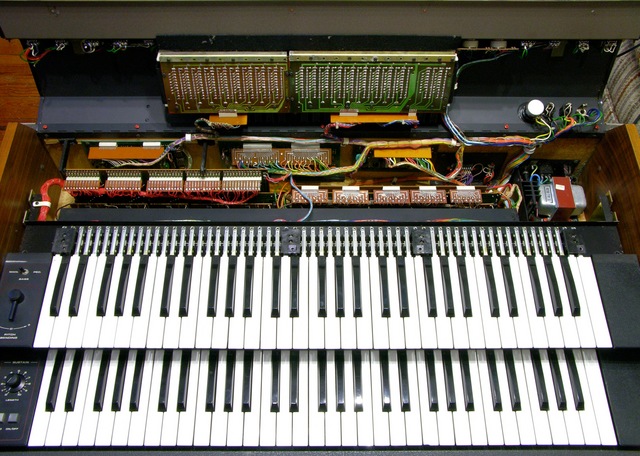
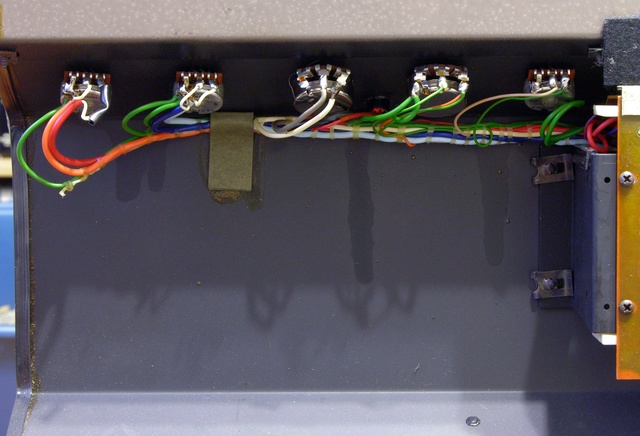
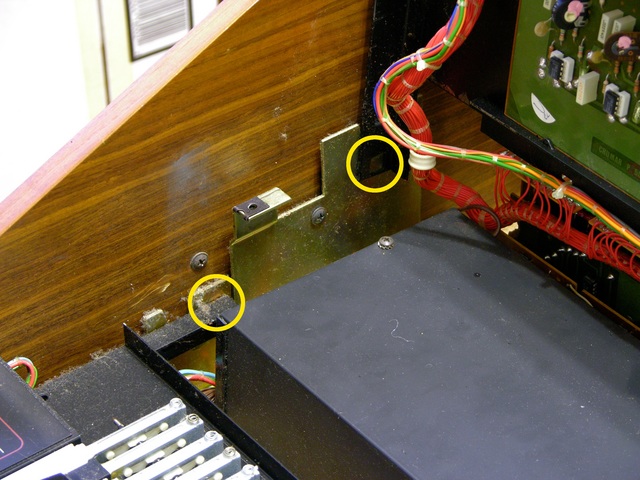
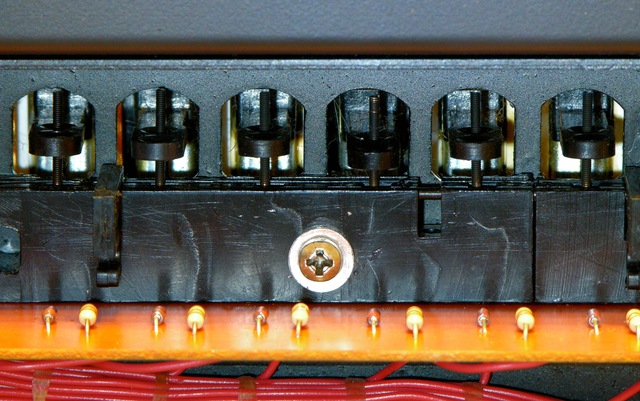
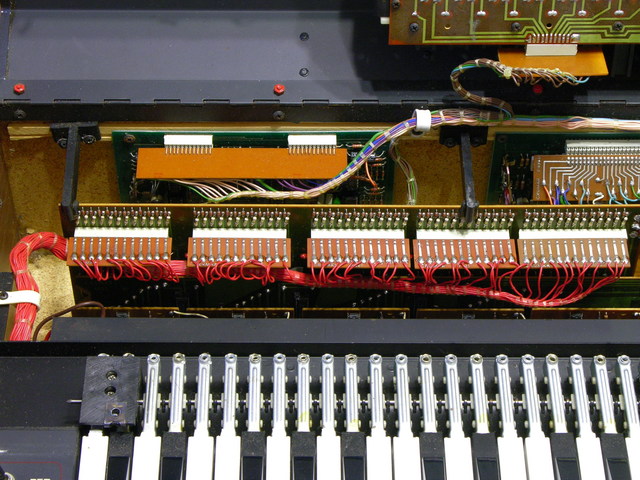
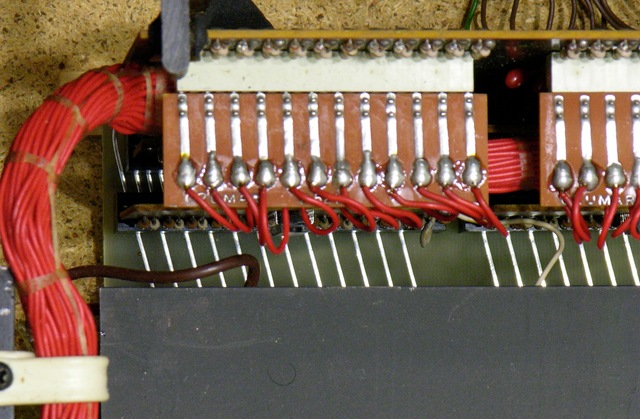
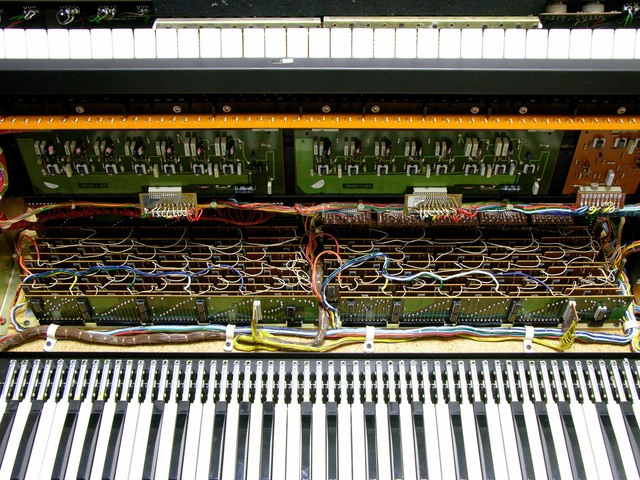
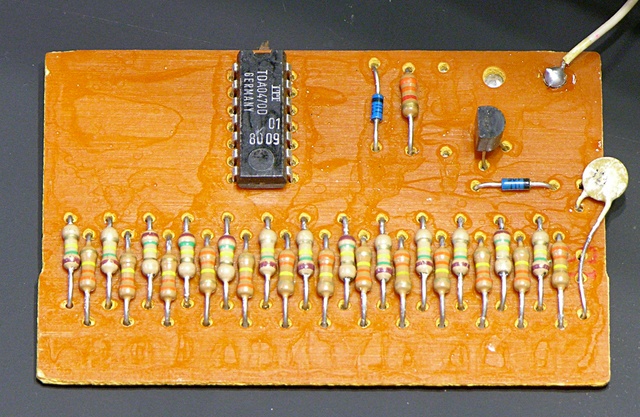
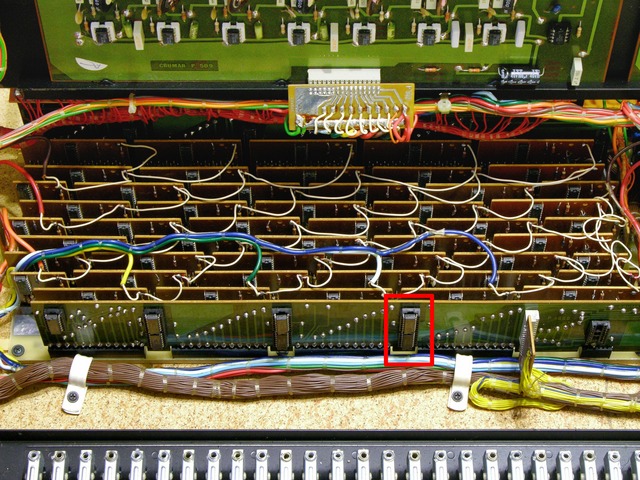
Love the old school lacing of the wire looms!
Duncan.
Duncan, I couldn’t agree more! I need to build something that needs laced cable harnesses in it.
I used to work for Plessey Traffic Controls. I was taught to chain lace using the older wax flat cord and it makes a nice job when doen properly.
The later round black plastic lacing cord (RS) was rubbish because it slips when you are trying to chain lace.
Im currently working on a Crumar Roadracer and a Crumar T1.
The Roadracer is up and running the T1 needs a bit more TLC.
Your description on the T2 was very helpful. I saved a T1 from the electro junkyard of my hometown in Germany. To my surprise it´s in a well condition. On my T1 all the D´s are working, but with some missing feet in theire tones.
The crackling keys I was cleaning with a 2″ brush, the kind of, what you need to paint doors, furniture e.g., (made of horsehair in my opinion).
I pushed it through the holes and springs carefully and I´m content with the result for the moment.
Sorry, I hope you get it all out of my english.
Greetings from Kaiserslautern, Germany
Willi
just beautiful pics .
.
Hello
I rescued a t1/c from the trash–All the lights light up and checking all the boards with a digital multi meter shows I have power at all the boards..problem is–no sound. I plugged into the “Main” and also the “signal output” jaacks one at a time–jammed a bunch of keys down–and nothing…any ideas where to look?
Doug, I think you should send it to me and let me salvage parts from it.


No, seriously, let’s figure out how to get it working for you. I only have a T1 and a T2 and I’m not sure what the differences are between the T1 and T1/C — could you send one or more pics of its control panel(s)?
For starters, I’d make sure the “Main” pot is all the way up and try different presets with keys held down, to make sure it’s not a misunderstanding about the drawbars.
Seriously, from the trash???
Hi, I have an Elgam sapphire organ, an Italian organ and have a problem with a 4727BPC. According to your experience, do you think that the 4727BPC can be replaced using the HBF4727?
As I read your writing I guess it can, but I´ll appreciate an advice to be sure.
Thanking you in advance,
Carlos
Carlos, I haven’t tried substituting an HBF4727 for a 4727BPC yet, but I’m led to believe it will work.
I’m also looking for a HBF4727 for my Viscount Fair Lady. The organ’s schematic has a block diagram of the IC which I can scan and email if that helps others, but I have not been able to locate a source to supply the part without paying more than what I paid for the complete organ (au $20). I was hoping to be able to replicate the IC using discrete IC’s on a strip board (Vero board).
Keith,
Thanks for your answer about the HBF4727 and 4727BPC, I will try it.
Thanks you,
Carlos
Keith,
Just to let you know that yesterday I bought a HBF4727 and I tried on the organ, and It seems to work great!!
Your article and answer were of great help. Thanks you very much!!
Carlos
Hello
I finished my T1/C restoration and everything is working–maybe…What does the “Add Organ” switch do? It is electrically functional but does nothing. Also the output of the organ is “bright” almost harsh in the upper octave–is there a component or pot that can tone down the treble? Other than that this thing really sounds great…
Doug, did you get yourself a service manual? I don’t remember the component numbers, but my suspicion is that you need to tweak the filter for the top octave down a little further — its square waves probably haven’t been low-passed far enough yet.
I have a full schematic for the T1/C..so it looks like I should tweak the pot on the Flute Filter board that controls the highest octaves…I am sure I tried this…but as soon as I finish the case and get it all together I will try again. Any idea what the “add organ” switch does?? I am thinking that it allows the organ to play with the bass generator on the lower 2 octaves..if thats so then I need to troubleshoot that. Thanks
I have just finished the restoration of a T2 Organizer which turned out to be a little tricky due to earlier fiddling. It sounds great through a Leslie speaker.
The schematics helped a lot in finding the various faults, I can email them to anybody who needs them. Keith, have you received the 4727 data sheet? I came across a post somewhere claiming a TMS3??? was an equivalent to the 4727 which I would like to verify.
Greetings from Germany, Christoph
Christoph, now that you mention it, no, I haven’t got the 4727 datasheet yet.
I still cannot find out what the “add organ” switch on the T1/C does…and I can’t find it in the schematics..??
Doug, you are sure the schematics belong to the Organizer T1/C (1981)? The “add organ” switch in the bass control section is one of the features the earlier Organizer T1 (1978) did not have. Otherwise, both models are pretty similar in apperance (and in technology, I assume).
I do not have the schematics of the Organizer T1/C. I have experienced switching problems with the Organizer T2 which were related to faulty CMOS ICs (4011, 4012 and alike) and could be found easily with help of the schematics. I do not have any documents of the TC/1. If I had, I could probably suggest something.
I have sent you a schematic the model I have—it is a Crumar T1/C organ–I don’t know if the organizer is different. I cannot find any reference to the “add organ” switch on the schematic. It has one light blue wire going to one terminal and two dark blue wires going to another terminal. The switch works according to my meter. but does nothing. The 3 wires get lost in the massive wiring harness. Because this k’board has had many hands in it over the years I am not even sure the switch is wired correctly. Maybe your eyes are better than mine reading schematics. Another poster told me that the switch is supposed to turn the bass section (lower 2 octaves) on and off….I suppose it is so you can play 2 octaves of bass only and the upper octaves are organ
only.
thanks
Doug
Message to Christoph
I have the Crumar T1/C schematics–e-mail me if you want a copy
Doug
Doug, please use this email adress: c r e l o n a (at) g m x (dot) d e
I will get back to you as soon as I find the time to look over the schematics.
Thanks. Christoph
Thanks all including Christoph for the help…my T1/C works 100%. Does anyone know how to set all the pots on the various boards–I have been adjusting them for best sound–I guess that is all that matters–its just that some seem to do nothing. Again thanks…if it were not for the internet this keyboard would be in the trash.
i have a t1 on the bench that had a fried regulator wasn’t working at all, i replaced the regulator but it still seems to get hot , i now have only the first octave working and no other keys, anyone have an idea whats wrong, also if anyone has the schematic full version it would be greatly appreciated please email me at sbsellitem@gmail.com
Nice to find this very current discussion on Crumar refurbishing. I have just acquired a T2 Organizer that I would like to get working. I’ve not attempted this sort of thing before and this seems like a friendly group from which to get some advice.
My first challenge is to repair or replace the power supply. The fuse holder is separated from the board and looks as though someone has attempted to resolder at one time. Am I wrong to assume that I can replace this component with standard panel mount 10 Amp, 250V, for 1/4 x 1 1/4 fuse?
Anything else one might do after replacing the fuse unit, prior to connecting power to the instrument?
Oh Lord: A place for Crumar Organ restoring – how wonderful !!!!
I`ve a T2 which worked well for years, but now makes strange and ugly (music independend ) noises: By touching the metal parts beneath the Keyboards, or even by knocking on the case it gives sounds like .. hmmm … “electronical thunder”.
) noises: By touching the metal parts beneath the Keyboards, or even by knocking on the case it gives sounds like .. hmmm … “electronical thunder”.
As these noises appear also after opening the Organ and by slightly moving the cables, it seems that NEARLY ALL connectors have to be cleaned – or maybe directly soldiered “cable – to – board” …
Before i start that work … is there anyone here having the same kinds of problem ??? Maybe there is just another fault with that organ which could been solved with less work …
What i`m wonderimg about is that this problem isn`t there shortly after switching the organ to “on”, but i could not recognize any broken board or dead soldering pin … hmmm …
Just mail … diegoetterdesfluxus@gmx.com
cleaning, cleaning, cleaning …. every single removable connector and every connector of every board with isopropyle alcohol … that seems to help … i hope not only for the moment ..
Hi. Yes, the TDA0470 is a transistor array used also in ARP synth. If you need some, I have cheaper than others!!!!
Just ask me at redcat1964@libero.it
Cheers.
Mick
Hi,
I´m trying to restore my Crumar Oraganizer T1. Does anyone have the schematics for this one. That would be great if someone could mail it to:
mikel.jacobsson@gmail.com
/ Mikael
Hey Keith. Great work, can’t wait for part 3!
I recently picked up a T1 with some similar problems, such as missing C/C#’s (and missing footages on keys where C or C# are harmonics). This blog entry was indispensable in tracing the problem to one divider chip. However, there are other things, such as organ fundamentals dropping out as you descend down the bass spectrum of the keyboard… could this also have to do with frequency division?
Additionally, the 8′ drawbar on only one B doesn’t sound (bad gate/transistor array?) and two presets don’t work (not that I care about presets, I’d simply love to have a fully functioning T1). I sprung for a service manual but, unlike Moog manuals, it’s completely engineer-speak. :/
Have you — or anyone — had any luck in sourcing one of these HBF4727s?
Thanks 1,000,000! — jordo
Jordan, I think Valter may have some for sale — check the links I posted.
I did end up finding a physically trashed unit to salvage, so I haven’t ordered online. I’m still convinced the ICs are out of production and pretty scarce.
Have you been able to fix the divider chip and still have the problems with fundamentals, or haven’t fixed the divider yet?
Because I’ve picked up some Hammond XB-2s, my attention has been drawn away from the Crumars and it may be a bit before I get back to them.
I have the first organ of Crumar: Organizer 1 (1975) in mint condition but Vibrato controlls died. Could anyone help me? It was also sold in US under the tm Univox.
For Andrew.
You say that vibrato is dead. OK, but what about the vibrato led: does it blink faster or slower as you turn the rate knob or not? And what about the tremolo:does it work or not. Vibrato and tremolo share the same oscillator. Blinking led and working tremolo means a bad vibrato pot or something wrong between the vib osc and the master osc ( 1 pot and 1 resistor or cables ).Dead led could mean a faulty 1458 or 741 ( vib oscillator chips ). They all live on the P489 board, the master oscillator board. Have fun!!!
Mick
Hi Keith!
Thanks for your answer. As I have allready said I’ve got an older model of Organizer. At that time (1975) it was called “Organizer 1″. It is predecessor of T1, based on transistors with 12 separate printed circuits, one for one tone (without dividers!). It has no LEDs. Look at
http://www.enricobassi.it/organizer.htm
Best Regards,
Keith: do you know if anyone has a PDF service manual for a T1 ?: my friend Tony (message below) and I are trying to repair one.
[The first night I was checking it out, I noticed it was quite severely out of tune and when I tried to turn the tuning pot on the back panel I found it was totally frozen. When I tried to turn the pot with vise grips, it broke and the keyboard stopped outputing musical sounds and only provided strange noises. I replaced the pot with another of the same value and it seemed to do the trick; it was working again (not at 100% but like it was working before). The very next night when I turned it on, something must have happened because now there is no sound output except dull clicking noises when keys are pressed. Also, the rate LED for the Vibrato/Tremolo section (which had previously been working fine), is now no longer blinking at the rate of the LFO like it should, it is now solidly on. So it seems like one or more chips which must have been on the brink have finally blown. I've noticed that most of the chips are in sockets which would make them fairly easy to replace, but at this point I have no idea where to start.]
Thanks in advance,
Bruce
Hi Bruce. I’ve got a pdf service manual for your T1…….found somewhere in the net. CA3080, uA741 and CD4016 are possible causes of ” no sound “. Well, I can send you the manual but need to know where.
Mick, Italy.
Hi,
I have a duo vox accordion with a crumar tone gen. (apprx-20yrs old).
The model is before the magic-vox came out.
PROBLEM:
treble Eb and F do not play (electronically).
Would you have a schematic (or know where I can get one) so that I can isolate problem to a particular pcb?
Thanks, in advance.
Victor
Someone gave me a salvaged Cumar keyboard said to be from a T2. Not in the best shape – it’s difficult to keep (or to believe that) the PCB attached to the assembly, and I am yet to think of a simple solution to keep the PCB stable where it is without means that may make future repairs difficult to impossible. Any tips?
Also, three of the springs that are soldered into the PCB and go through the slots into the keys in order to touch the ‘bus’ are kinked/twisted/etc. Anyone have a source or some to spare?
All the springs are gold on the soldered end but corodded black on the keypad end. Some De-oxit helped it get a little more grey than black, but it’d be nice to know how to really get it all back to clean contact – without destroying any additional springs in the process!
I AM LOOKING FOR A SET OF BASS PEDALS FOR MY CRUMAR T2. I LOST MINE IN THE HURRICANE. PLEASE CONTACT ME AT CRYERF@BELLSOUTH.NETOR CALL COLLECT 337-439-6439 THANKS Y9U. FINERS CRYER
I HAVE A CRUMAR T1; T2, AND T3. I LOVE MY CRUMAR. HOWEVER I LOST MY T2 BASS PEDALS IN A HURRICANE AND HAVE NOT BEEN ABLE TO REPLACE THEM. CAN ANYONE HELP ME?
Hey is this page still alive? Im currently restoring a T2 and on the hunt for the manual and some advice..Cheers
Have T1 that is 80 percent restored but the b and b flat with the draw bars 16 ,8,4,2 has no sound. the other draws give sound on these notes. also the percussion delay has a ringing sound fully out.if the percussion is selected on the settings other then 16,8,4,2 then it sounds OK. any ideas. Thanks!
I Have t1 that is mostly all there. I had to fix the power supply one of the 15 volt regulator was out. The P487B card had small caps shorted. I reversed engineered the schematic diagram and showed board layout componet names. Also names and colors of the in and out put wires. I’m in the process of replacing the small caps.